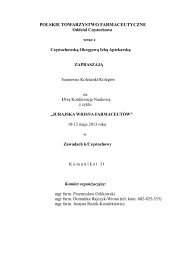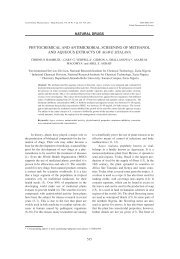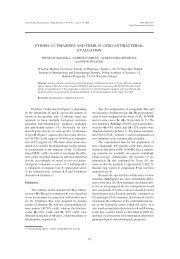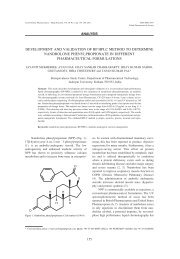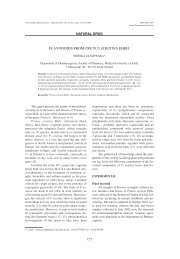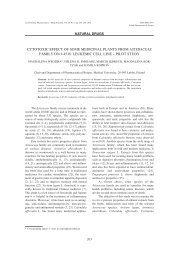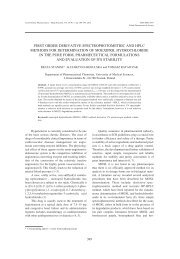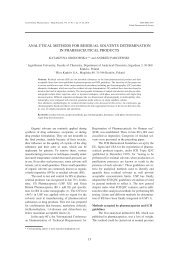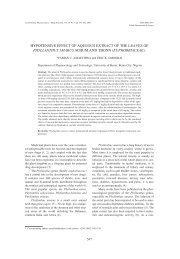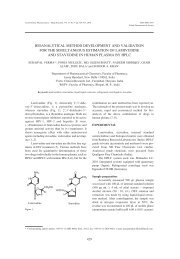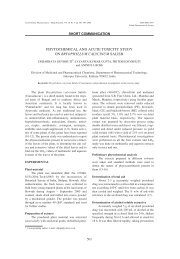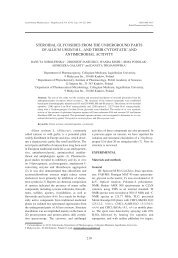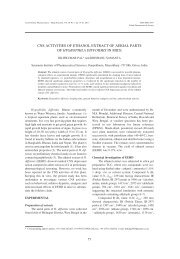A HIGH Å PERFORMANCE LIQUID CHROMATOGRAPHY WITH ...
A HIGH Å PERFORMANCE LIQUID CHROMATOGRAPHY WITH ...
A HIGH Å PERFORMANCE LIQUID CHROMATOGRAPHY WITH ...
You also want an ePaper? Increase the reach of your titles
YUMPU automatically turns print PDFs into web optimized ePapers that Google loves.
Acta Poloniae Pharmaceutica ñ Drug Research, Vol. 65 No. 6 pp. 759ñ762, 2008 ISSN 0001-6837<br />
Polish Pharmaceutical Society<br />
A <strong>HIGH</strong> ñ <strong>PERFORMANCE</strong> <strong>LIQUID</strong> <strong>CHROMATOGRAPHY</strong><br />
<strong>WITH</strong> ELECTROCHEMICAL DETECTION FOR THE DETERMINATION<br />
OF OLANZAPINE IN HUMAN PLASMA<br />
KAMILA KOBYLI—SKA*, KATARZYNA M. BUå and MIROS£AWA BUKOWSKA-KILISZEK<br />
Department of Pharmacology, Pharmaceutical Research Institute, 8, Rydygiera St., 01-793 Warsaw, Poland<br />
Keywords: olanzapine, HPLC, electrochemical detection, validation<br />
Olanzapine, 2-methyl-4-(4-methyl-1-piperazinyl)-10H-thieno[2,3-b][1,5]benzodiazepine,<br />
is an<br />
atypical antipsychotic drug with a high affinity for<br />
serotonin (5HT 2A/2C ), dopamine (D 1-4 ), muscarinic<br />
(M 1-5 ), histamine H 1 , and α 1 -adrenergic receptors<br />
(1). Olanzapine is indicated for the treatment of<br />
patients with schizophrenia and psychosis of a<br />
schizoaffective nature. Olanzapine is well absorbed<br />
following oral administration and reaches peak concentrations<br />
in approximately 6 h. The pharmacokinetics<br />
of olanzapine is linear and dose-proportional<br />
within the approved dosage range. Its mean half-life<br />
in healthy subject was 33 h. Olanzapine is metabolized<br />
by the cytochromes P450 (CYP), and in particular<br />
by the isozymes CYP1A2 and CYP2D6. One<br />
of the main metabolites is N-desmethylolanzapine<br />
(2).<br />
This paper describes a relatively simple and<br />
reproducible method for the determination of olanzapine<br />
in human plasma, using liquid ñ liquid<br />
extraction and electrochemical detection.<br />
EXPERIMENTAL<br />
Materials and reagents<br />
Olanzapine was supplied by Pharmaceutical<br />
Research Institute, Warsaw, Poland. Clozapine (the<br />
internal standard) was supplied by Nobilus Ent.,<br />
Warsaw, Poland. HPLC-grade methanol, acetonitrile,<br />
ethyl acetate were purchase from LabScan,<br />
Dublin, Ireland. All other reagents were of analytical<br />
grade.<br />
Standards<br />
The stock standard solution of olanzapine (1<br />
mg/mL) was prepared in ethanol and then diluted<br />
100-fold with methanol to give the final concentration<br />
of 10 µg/mL. From this working solution the<br />
calibration standards were prepared containing<br />
0.313, 0.625, 1.25, 2.50, 5.00, 10.00, 20.00 and<br />
25.00 ng/mL of olanzapine by appropriate dilutions<br />
with blank plasma. Quality control (QC) samples<br />
were prepared in the same way at concentrations of<br />
0.625, 5.00 and 20.00 ng/mL, divided into 0.5 mL<br />
portions and stored at -70 O C.<br />
The stock standard solution of internal standard<br />
clozapine (1mg/mL) was prepared in methanol<br />
and was diluted in methanol to produce the final<br />
concentration of 600 ng/mL.<br />
Apparatus and chromatographic conditions<br />
The HPLC system consisted of Shimadzu<br />
series VP model including a pump (LC-10ADVP),<br />
an autosampler (SIL-10 ADVP) and a controller<br />
(SCL-10 AVP). The electrochemical detector was<br />
DECADE II, Antec Leyden, The Netherlands. The<br />
system was connected to a personal computer with<br />
Class-VP software v.6.12 SP5 (Shimadzu) for data<br />
collection and processing.<br />
The separation was performed on a 125 ◊ 4.0<br />
mm i.d., 5 mm particle size Symmetry C18 column<br />
(Waters, Milford, MA, USA), preceded by a 4 ◊ 3.0<br />
mm i.d. C18 guard column (Phenomenex, Torrance,<br />
CA, USA). The column was heated at 36 O C. The<br />
mobile phase consisted of 0.06 M ammonium<br />
acetate buffer, pH 5.9, acetonitrile and methanol (40<br />
: 41 :3 7, v/v/v) and was delivered at a flow-rate of<br />
0.69 mL/min.<br />
The electrochemical detection conditions were:<br />
DC Mode, E ox + 0.60 V, range 5 nA, filter 0.01 Hz,<br />
offset 10%, spacer 50 µm. The cleaning electrode<br />
conditions were: Pulse Mode, potential E1 =<br />
* Corresponding author: k.kobylinska@ifarm.waw.pl<br />
759
760 KAMILA KOBYLI—SKA et al.<br />
Figure 1. Chromatograms of (A) blank human plasma, (B) spiked human plasma with 5 ng/mL of olanzapine and 30 ng/ml of I.S. and (C)<br />
plasma sample from a volunteer at 4.0 h after drug administration; the retention times for olanzapine and I.S. were 4.9 and 8.2, respectively<br />
+0.60V, E2 = + 1.50 V, E3 = ñ 0.30 V; times of t 1 =<br />
500 ms, t 2 = 800 ms, t 3 = 500 ms.<br />
The working and the reference electrodes were<br />
glassy carbon and Ag/AgCl, respectively.<br />
Sample preparation<br />
The blood samples drawn from the volunteers<br />
were collected into EDTA containing tubes, centrifuged<br />
at 3500 rpm for 10 min and the plasma was<br />
decanted. Then, 30 µL of 25 % ascorbic acid solution<br />
was added to each 3 mL of plasma samples and<br />
the samples were frozen at ñ70 O C. The addition of<br />
the ascorbic acid to serum protects olanzapine<br />
against oxidation during extraction and storage.<br />
The frozen plasma samples were thawed at<br />
room temperature. 25 µL of the I. S. solution was
A high ñ performance liquid chromatography with electrochemical... 761<br />
Figure 2. Olanzapine plasma concentration-time curve in a volunteer following a single 10 mg oral dose of olanzapine.<br />
added to 0.5 mL of plasma samples and the tubes<br />
were stirred vigorously. Then, 0.25 mL of sodium<br />
carbonate solution (0.04 M) was added to each tube,<br />
mixed, and left at room temperature for 5 min. Then,<br />
2 mL of ethyl acetate was added to each tube. The<br />
solutions were shaken at 1000 rpm for 2 min and<br />
centrifuged at 3500 rpm for 5 min. After freezing at<br />
ñ70 O C for 10 min, the organic layer was transferred<br />
to another glass tube and evaporated to dryness at<br />
45 O C under a gentle stream of nitrogen. The sample<br />
residue was dissolved in 200 µL of methanol by vortexing<br />
for 10 s, then 200 µL of 0.06 M ammonium<br />
acetate solution (pH 6.9) was added. After mixing<br />
the sample was centrifuged, then the solution was<br />
transferred to an autosampler vial. An aliquot of 30<br />
µL was injected onto the HPLC system for analysis.<br />
RESULTS<br />
Method validation<br />
Typical chromatograms of drug-free human<br />
plasma and plasma spiked with olanzapine and the<br />
internal standard, as well as a plasma sample from a<br />
subject dosed with olanzapine and spiked with the<br />
internal standard are illustrated in Figure 1. The<br />
retention times of olanzapine and the internal standard<br />
were 4.9 and 8.2 min, respectively. There were<br />
no endogenous peaks in control plasma that coeluted<br />
with olanzapine or the internal standard, indicating<br />
that the method was selective.<br />
The detection limit based on signal to noise<br />
ratio 3/1 was 0.07 ng/mL and the lower limit of<br />
quantification (LLOQ) was 0.313 ng/mL (n = 6,<br />
RSD = 9.86 %). An average recovery of 91.37 ±<br />
2.5% (mean ± SD) was obtained in concentrations<br />
(0.625, 5.00 and 20.00 ng/mL) studied (n = 6). The<br />
mean recovery for the internal standard was 81.6 ±<br />
1.6 % (n = 6).<br />
The method was linear over the range 0.313-<br />
25.00 ng/mL. The best calibration curve was<br />
obtained using 1/concentration 2 weighted linear<br />
regression (peak height ratio of olanzapine vs. I.S.,<br />
plotted against the concentration of olanzapine). The<br />
regression equation was y = 0.0799x ñ 0.0005 and r<br />
= 0.997 (n = 6).<br />
The precision and accuracy of the method were<br />
evaluated by the intra- and inter-day (n = 6) assays<br />
at three different concentrations of olanzapine<br />
(0.625, 5.00 and 20.00 ng/mL). The intra-day precision<br />
ranged between 2.79 and 6.01 % whereas the<br />
inter-day was between 7.10 and 8.03 %. The intraday<br />
and inter-day accuracy ranges were 91.7 ñ 103.7<br />
% and 101.9 ñ 104.4 %, respectively.<br />
The stability of olanzapine was studied under a<br />
variety of storage and handling conditions. The<br />
results showed that no significant degradation<br />
occurred at room temperature for 4 h and during three<br />
freeze-thaw cycles for olanzapine plasma samples.<br />
Olanzapine and the I.S. in reconstituted sample<br />
extracts were stable for 18 h at room temperature.<br />
Finally, the storage at ñ70 O C during 5 months showed<br />
good stability of olanzapine in plasma samples.<br />
Application<br />
The validated method has been successfully<br />
used to quantify olanzapine concentrations in human
762 KAMILA KOBYLI—SKA et al.<br />
plasma samples after the administration of a single<br />
10 mg oral dose of olanzapine in a bioequivalence<br />
study conducted in healthy subjects. The representative<br />
plasma concentration versus time profile for one<br />
volunteer receiving a single oral 10 mg dose is presented<br />
in Figure 2.<br />
DISCUSSION AND CONCLUSION<br />
Various analytical methods, including gas<br />
chromatography-mass spectrometry (3), high performance<br />
liquid chromatography (HPLC) with electrochemical<br />
(3, 4) or UV (5, 6) detection, liquid<br />
chromatography-tandem mass spectrometry (7, 8),<br />
have been developed for the determination of olanzapine<br />
in biological samples. The existing HPLC-<br />
UV assays were considered to be of insufficient sensitivity<br />
(e.g. LLOQ 1.5-10 ng/mL). Although the<br />
HPLC method with electrochemical detection (3)<br />
was sufficiently sensitive (LLOQ = 0.25 ng/mL utilizing<br />
a 1 mL plasma sample), this method required<br />
solid-phase extraction which is rather complicated<br />
and involves several washing steps with buffers and<br />
other solutions. A recently published LC-MS/MS<br />
method (8) provided high sensitivity with LLOQ =<br />
0.1 ng/mL and selectivity for the determination of<br />
olanzapine in human serum. However, a lot of laboratories<br />
do not have access to this technique, so a<br />
simpler assay method must be developed.<br />
The presented assay may be used as an alternative<br />
to previous HPLC methods with electrochemical<br />
detection, because it employs a simple one-step<br />
liquid-liquid extraction scheme and has a limit of<br />
quantitation (0.313 ng/mL) which is enough to<br />
measure plasma olanzapine concentration up to 120<br />
h following administration of 10 mg dose.<br />
Moreover, because of the short time of the chromatographic<br />
analysis, this method allows the quantification<br />
of a large number of samples daily.<br />
In summary, the described HPLC method is<br />
simple, sensitive, specific and appropriate to be used<br />
for the determination of plasma olanzapine in bioequivalence<br />
studies.<br />
REFERENCES<br />
1. Kando J.C., Shepski J.C., Satterlee W. et al.:<br />
Ann. Pharmacother. 31, 1325 (1997).<br />
2. Callaghan J.T., Bergstrom R.F. et al.: Clin.<br />
Pharmacokinet. 37, 177 (1999).<br />
3. Catlow J.T., Barton R.D., Clemens M. et al.: J.<br />
Chromatogr. B 668, 85 (1995).<br />
4. Raggi M.A., Casamenti G., Mandrioli R. et al.:<br />
J. Chromatogr. B 750, 137 (2001).<br />
5. Dusci L.J., Hackett L.P., Fellows L.M. et al.: J.<br />
Chromatogr. B 773, 191 (2002).<br />
6. Weigmann H., Hartter S., Maehrlein S. et al.: J.<br />
Chromatogr. B 759, 63 (2001).<br />
7. Berna M., Ackermann B., Ruterbories K. et al.:<br />
J. Chromatogr. B 767, 163 (2002).<br />
8. Nirogi R.V., Kandikere V.N., Shukla M. et al.:<br />
J. Pharm. Biomed. Anal. 42, 935 (2006).



